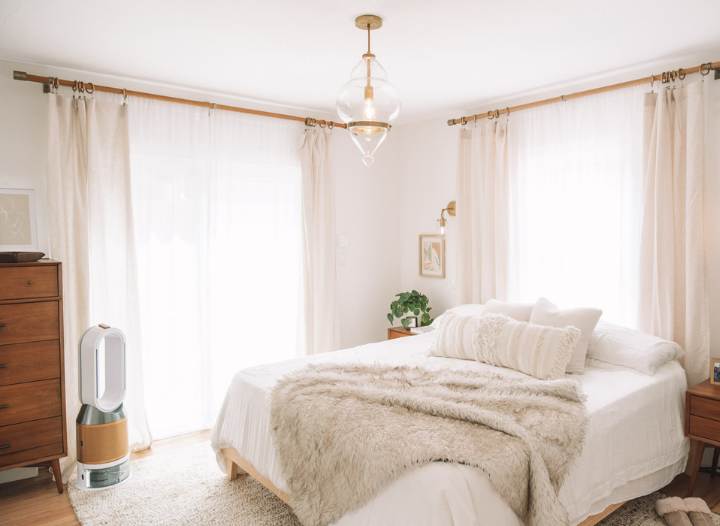A visit to Paris’s fifth arrondissement can make you feel unusually nostalgic in the current climate. Home to the Sorbonne, student-filled cafés and all-round Rive Gauche cool, it’s a world away from France on the brink of change. Also known as the Latin Quarter, le cinquième has ready supplies of retro charm and specialist shops to browse and lose yourself in.
On an early-evening wander, I come across a shop on rue des Écoles that sells mandolins and a rare bookshop on rue du Cardinal-Lemoine with a window display of ironic protest material, including a copy of the Watergate Cookbook. Near the Seine, you’ll find the Jardin des Plantes botanical gardens and the Natural History Museum, all just a stone’s throw away.
Mostly, the area is comfortingly solid and unchanging, with its graceful 19th-century buildings and Emily-in-Paris-style boulangeries – until, that is, you reach rue de Poissy, and you’re faced with the Brutalist concrete facade of the new Hôtel Pilgrim. Once a garage, it is now ready to take guests on a different sort of nostalgia trip: back to the 1970s.
If you’re old enough to remember it, that particular decade comes in all shades of opinion. But most agree it was a superb era for furniture, putting the focus on domestic comfort with groovy curves rather than sharp-edged elegance – an element that the Hôtel Pilgrim determinedly celebrates.
Downstairs, the sofas, including a Mario Bellini modular version in cheerfully fat blue corduroy, are squidgy rather than sleek. There are also 70s-appropriate batiks. Having grown up in this era, it feels like I’m coming home, but to an altogether more stylish version.
Naturally there’s plenty of orange. I was part of the least hip family in the universe, but even we had orange plastic Habitat kitchen chairs when I was growing up. The Pilgrim has embraced orange, but the general tone is gentler, less citrus, more like the terracotta hues of the chicken brick, which was my father’s pride and joy.
I can’t help wondering if the Pilgrim’s designers were old enough to experience the 70s in its original format but, even so, the mood is refreshing. Colourful and comfortable, it’s a welcome change from midcentury with its steady diet of tapered chair legs and geometric-minded minimalism. As hotel design goes, this is altogether more relaxed and friendly.
And it seems to work. The Pilgrim is the cheeriest Paris hotel I’ve ever stayed in; the guests chat to each other while drinking cocktails and playing the board games provided. There’s no restaurant, but opposite the mandolin shop is Bonvivant, which lives up to its name as a proper neighbourhood wine bar.
Another win is in the basement – which features a swimming pool for guests that has to be reserved (at no extra cost), so it never gets crowded. There are massage beds and 70s wall tiles in familiar hues of orange and brown.
The next morning I drop in on the Centre Pompidou, built by Richard Rogers and Renzo Piano, which opened in 1977. It’s been a divisive piece of architecture ever since, but if you find the Louvre oppressive (and I do), the light-filled Pompidou and its connection with its environment is a joy. Make the most of it now, as it’s due to close from the end of 2024 for a lengthy renovation.
The city’s other statement architecture of the 70s, Les Halles, rapidly became a rendezvous for both drug-dealing and edgy fashion shoots. Demolished in 2010, it’s now a Westfield shopping centre, which makes me feel that the Pompidou Centre – and the Pilgrim – should be cherished all the more.
The Hôtel Pilgrim, 11 rue de Poissy, Paris, has double rooms from £175 (hotelpilgrim.paris)
The big sleep: three more fabulous European hotels rocking a 70s vibe
The Standard, London
Camden council built this library and office building opposite King’s Cross station, with its distinctive egg box design, in 1979. Now, the ground floor Library bar celebrates the era with a glorious mix of seriously sourced furniture, overgrown houseplants and a book collection that takes in both the kitsch and the thoughtful.
Room-only doubles from £192 (standardhotels.com)
Hoxton Brussels
Housed in IBM’s former headquarters, Victoria Tower’s Brutalist exterior gives way to early Mike Leigh 1970s exuberance within, with pink bathrooms, vintage furniture, velvet sofas and rotary phones. However, away from the retro rooms and suites things get more 2020s with Peruvian-inspired food at the cool Cantina Valentina.
Room-only doubles from £168 (thehoxton.com/brussels)
Hotel Oddsson, Reykjavík
Exposed ducts (installed for Iceland’s geothermal heating), textured wallpaper, modular sofas by Mario Bellini, pink bathroom sinks and a belief in egalitarian and affordable hotels for all. Rooms at this Icelandic hotel come in every configuration, all with direct access to Reykjavík’s groovy Grensásvegur area.
B&B doubles from £139 (oddsson.is)







